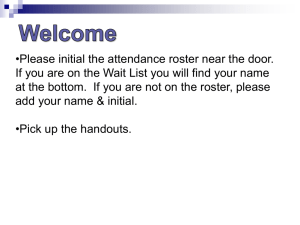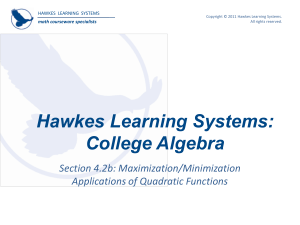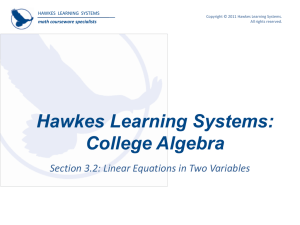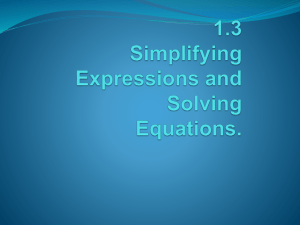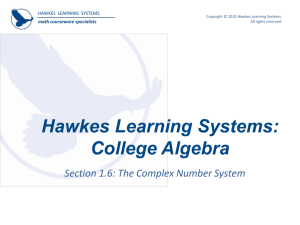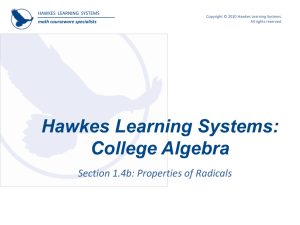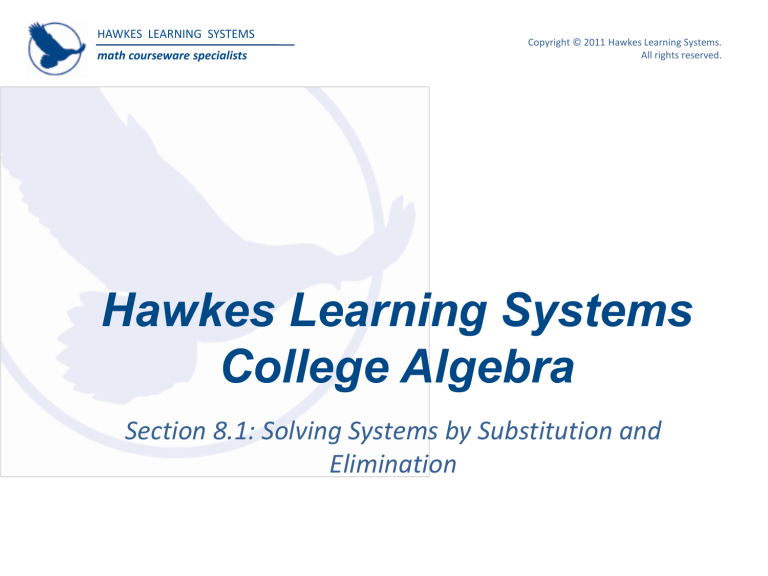
HAWKES LEARNING SYSTEMS
math courseware specialists
Copyright © 2011 Hawkes Learning Systems.
All rights reserved.
Hawkes Learning Systems
College Algebra
Section 8.1: Solving Systems by Substitution and
Elimination
HAWKES LEARNING SYSTEMS
Copyright © 2011 Hawkes Learning Systems.
All rights reserved.
math courseware specialists
Objectives
o Definition and classification of linear systems of
equations.
o Solving systems of equations using substitution.
o Solving systems of equations using elimination.
o Larger systems of equations.
o Applications of systems of equations.
HAWKES LEARNING SYSTEMS
math courseware specialists
Copyright © 2011 Hawkes Learning Systems.
All rights reserved.
Linear Systems of Equations
Many problems of a mathematical nature are most
naturally described by two or more equations in two or
more variables. A collection of linear equations is called a
linear system of equations, or simultaneous linear
equations.
The three graphs below pictorially identify the three
possible varieties of systems of two linear equations in two
variables.
HAWKES LEARNING SYSTEMS
Copyright © 2011 Hawkes Learning Systems.
All rights reserved.
math courseware specialists
Linear Systems of Equations
Varieties of Linear Systems
The chart below illustrates the only possible solutions
to any linear system of equations. If a system of linear
equations has
No
Solutions
One
Solution
The
system is Inconsistent Consistent
called
Infinite
Solutions
Dependent
HAWKES LEARNING SYSTEMS
math courseware specialists
Copyright © 2011 Hawkes Learning Systems.
All rights reserved.
Solving Systems by Substitution
The solution method of substitution works by solving
one equation and substituting the result into the
remaining equations, a method that may require
several repetitions. This method can be time
consuming for large systems where there are many
equations and variables, but for smaller systems, this
method works well.
HAWKES LEARNING SYSTEMS
Copyright © 2011 Hawkes Learning Systems.
All rights reserved.
math courseware specialists
Solving Systems by Substitution
For example, we’ll demonstrate solving the system
2 x y 1
by substitution.
x
y
5
We’ll show two (of the four possible) ways of solving this system of equations by
substitution.
Possibility 1:
2x y 1
y 2x 1
x 2 x 1 5
Possibility 2:
Choose an equation.
Solve for a variable.
Insert the solution into
the other equation.
x y 5
x 5 y
2 5 y y 1
Solve for the
3x 6
other variable.
x2
y 2 2 1 3 Solution is (2,3).
9 3y
y 3
x 5 3 2
HAWKES LEARNING SYSTEMS
math courseware specialists
Copyright © 2011 Hawkes Learning Systems.
All rights reserved.
Solving Systems by Substitution
If we observe the graph of the two linear equations in
the system we solved on the previous slide, we can see
that the solution we found, (2,3), does indeed satisfy
the system.
HAWKES LEARNING SYSTEMS
Copyright © 2011 Hawkes Learning Systems.
All rights reserved.
math courseware specialists
Example 1: Solving Systems by Substitution
Solve the system by substitution.
3 x 2 y 5
4 x y 3
4x y 3
y 4x 3
3 x 2 4x 3 5
3x 8 x 6 5
11x 11
x 1
y 4 1 3 1
Choose an equation. (You could have
chosen either!)
Solve for a variable. We choose y.
Insert the solution found for y into
the other equation.
Solve for the other variable. In this
case, x.
Thus, the solution is (1,1).
HAWKES LEARNING SYSTEMS
Copyright © 2011 Hawkes Learning Systems.
All rights reserved.
math courseware specialists
Example 2: Solving Systems by Substitution
Solve the system by substitution.
x 2 y 4
3 x 6 y 12
x 2y 4
x 2y 4
3 2 y 4 6 y 12
6 y 12 6 y 12
00
This is a true and trivial statement which
implies that there are an infinite number of
solutions. In other words, for any x-value,
there exists a y-value that satisfies the system.
HAWKES LEARNING SYSTEMS
math courseware specialists
Copyright © 2011 Hawkes Learning Systems.
All rights reserved.
Solving Systems by Elimination
The method of elimination is based on the goal of
eliminating one variable by adding two equations
together (some texts call this the addition method).
The elimination method works because of the following
truth:
If A B and C D then A C B D .
Proof: We know that A C A C .
Since A B, it must be true that A C B C .
Similarly, C D so, A C B D .
Thus, the above statement, “If A B and C D
then A C B D ,” is true.
HAWKES LEARNING SYSTEMS
math courseware specialists
Copyright © 2011 Hawkes Learning Systems.
All rights reserved.
Solving Systems by Elimination
For example, we’ll demonstrate solving the following
system by the method of elimination.
x y 2
3 x 6 y 3
First, we’ll try adding the equations to see if any variables are eliminated.
3 x y 2
3x 6 y 3
Not
4 x 5 y 1
helpful!
3 x 3 y 6
3x 6 y 3
9 y 9
Adding the equations as they are doesn’t help us, so let’s try manipulating
one (or both) of the equations by multiplying both sides of that equation by a
constant. If we multiply the first equation by ̶ 3 and add the equations again,
the x variable will be eliminated.
Continued on the next slide…
HAWKES LEARNING SYSTEMS
math courseware specialists
Copyright © 2011 Hawkes Learning Systems.
All rights reserved.
Solving Systems by Elimination
We found
9 y 9
y 1.
Now we can plug in y into either of the equations in the system.
x 1 2
x 1
Thus, the solution to the system is 1, 1 .
HAWKES LEARNING SYSTEMS
math courseware specialists
Copyright © 2011 Hawkes Learning Systems.
All rights reserved.
Example 3: Solving Systems by Elimination
Solve the system by the method of elimination.
5 x 2 y 6
2 x 3 y 10
To eliminate a variable, you’ll need to multiply each equation by a unique
constant. Let’s eliminate y. To do so, notice that we’ll have to multiply the first
equation by 3 and the second equation by 2.
3 5 x 2 y 6
2 2 x 3 y 10
5 2 2 y 6
y 2
15 x 6 y 18
4 x 6 y 20
19 x 38
x2
Thus, the solution is 2, 2 .
HAWKES LEARNING SYSTEMS
math courseware specialists
Copyright © 2011 Hawkes Learning Systems.
All rights reserved.
Example 4: Solving Systems by Elimination
Solve the system by the method of elimination.
x y 6
4 x 4 y 5
4
x y 6
4 x 4 y 5
4 x 4 y 24
+ 4x 4 y 5
0 29
This equation is false, so the solution to this system is (there are no
solutions).
HAWKES LEARNING SYSTEMS
Copyright © 2011 Hawkes Learning Systems.
All rights reserved.
math courseware specialists
Larger Systems of Equations
Algebraically, larger systems of equations can be dealt with
in a similar manner to the systems we have been looking at.
However, graphically, larger systems are very different.
The table below highlights the differences between
equations in three variables and equations in two variables.
An equation in
2 variables
3 variables
If a solution
exists, it is
called an
ordered pair
(x,y)
ordered triple
(x,y,z)
The graph
contains
The graph is
2 axes
2 dimensional
3 axes
3 dimensional
HAWKES LEARNING SYSTEMS
Copyright © 2011 Hawkes Learning Systems.
All rights reserved.
math courseware specialists
Larger Systems of Equations
Below is a graphical representation of the ordered
triple, 2,1,3 .
z -axis
2,1,3
3
1
x-axis
origin 0,0,0
2
y -axis
HAWKES LEARNING SYSTEMS
Copyright © 2011 Hawkes Learning Systems.
All rights reserved.
math courseware specialists
Example 5: Larger Systems of Equations
x y z 3
I
Solve the system 9 x y 7 z 1 II
2 x 5 y 4 z 17 III
Select two equations and eliminate one variable. We’ll eliminate y from
equations (I) and (II).
I x y z 3
II 9 x y 7 z 1
10x
8z 2
Continued on the next slide…
HAWKES LEARNING SYSTEMS
math courseware specialists
Copyright © 2011 Hawkes Learning Systems.
All rights reserved.
Example 5: Larger Systems of Equations(cont.)
Select two other equations and eliminate the same variable, y. We chose
equations (I) and (III).
I 5 x y z 3
III 2 x 5 y 4 z 17
5 x 5 y 5 z 15
2 x 5 y 4 z 17
7x
9z 2
We have now found two linear equations in two variables. Now we will solve
those equations by the elimination method.
7 10 x 8 z 2
10 7 x 9 z 2
70 x 56 z 14
70 x 90 z 20
34 z 34
z 1
Continued on the next slide…
HAWKES LEARNING SYSTEMS
Copyright © 2011 Hawkes Learning Systems.
All rights reserved.
math courseware specialists
Example 5: Larger Systems of Equations (cont.)
We know that z = –1. We’ll back substitute into one of the linear equations in
two variables. We chose the second equation found.
7 x 9 z 2
7 x 9 1 2
7 x 9 2
7 x 7
x 1
Back substitute the values found into an original equation; we chose
equation (I).
x yz 3
1 y 1 3
Solution: 1,3, 1
y03
y3
HAWKES LEARNING SYSTEMS
math courseware specialists
Copyright © 2011 Hawkes Learning Systems.
All rights reserved.
Example 6: Applications of Systems of Equations
Joey has $128 in his pocket in $10, $5, and $1 bills.
There are 19 bills in all and he has four more $5 bills
than $1 bills. How many bills of each kind does Joey
have?
x = the number of $10 bills
y = the number of $5 bills
z = the number of $1 bills
Come up with a system of equations from the information given.
x y z 19
I There are 19 bills.
10 x 5 y z 128 II The total value is $128.
$5 than $1 bills.
III There are four moreContinued
y z 4
on the next slide…
HAWKES LEARNING SYSTEMS
Copyright © 2011 Hawkes Learning Systems.
All rights reserved.
math courseware specialists
Example 6: Applications of Systems of
Equations (cont.)
Now we can solve the system of equations.
I 10 x y z 19
II 10 x 5 y z 128
10 x 10 y 10 z 190
10x 5y
z 128
5y 9 z 62
Note: One of the equations in the system, y = z + 4 is already an equation in
two variables, y and z.
5 z 4 9 z 62
5 z 20 9 z 62
14 z 42
z 3
Continued on the next slide…
HAWKES LEARNING SYSTEMS
Copyright © 2011 Hawkes Learning Systems.
All rights reserved.
math courseware specialists
Example 6: Applications of Systems of
Equations (cont.)
y 3 4
y7
x 7 3 19
x 10 19
x9
Solution: 9,7,3
Thus, Joey has nine $10 bills, seven $5 bills and three $1 bills.

